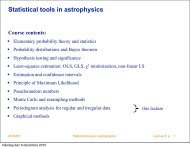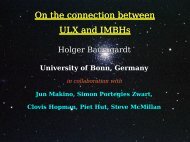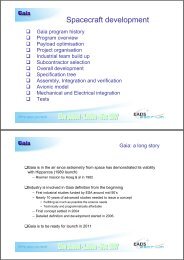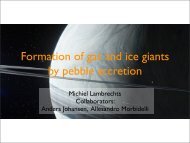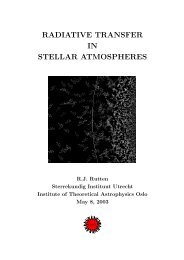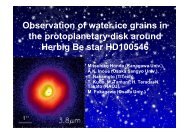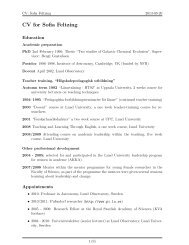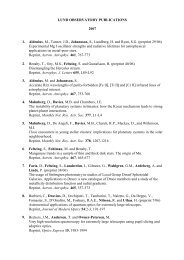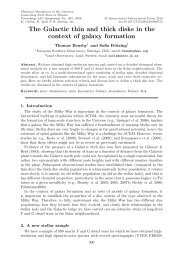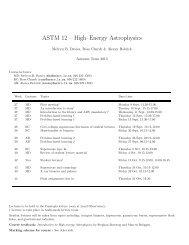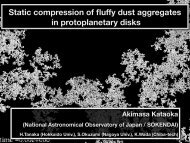Simulating galaxy formation: sub-grid models at the intermediate scale
Simulating galaxy formation: sub-grid models at the intermediate scale
Simulating galaxy formation: sub-grid models at the intermediate scale
You also want an ePaper? Increase the reach of your titles
YUMPU automatically turns print PDFs into web optimized ePapers that Google loves.
<strong>Simul<strong>at</strong>ing</strong> <strong>galaxy</strong> <strong>form<strong>at</strong>ion</strong>:<br />
<strong>sub</strong>-<strong>grid</strong> <strong>models</strong> <strong>at</strong> <strong>the</strong><br />
intermedi<strong>at</strong>e <strong>scale</strong><br />
Alexander Hobbs<br />
ETH Zürich<br />
Collabor<strong>at</strong>ors:<br />
Sergei Nayakshin, Chris Power, Justin Read,<br />
Seung-Hoon Cha, Andrew King
http://www.strw.leidenuniv.nl/~booth/movies/25mpc-object1-dens.avi
A pretty movie...<br />
...but wh<strong>at</strong> is actually<br />
going on here?
Simul<strong>at</strong>ion and movie credit: Craig Booth (Schaye et al., 2010)
M halo<br />
~ 10 14 M sun<br />
~ 500 kpc<br />
Simul<strong>at</strong>ion and movie credit: Craig Booth (Schaye et al., 2010)
M halo<br />
~ 10 14 M sun<br />
~ 500 kpc<br />
S<strong>at</strong>ellites/Dwarfs?<br />
Simul<strong>at</strong>ion and movie credit: Craig Booth (Schaye et al., 2010)
IGM<br />
M halo<br />
~ 10 14 M sun<br />
~ 500 kpc<br />
S<strong>at</strong>ellites/Dwarfs?<br />
Simul<strong>at</strong>ion and movie credit: Craig Booth (Schaye et al., 2010)
Wh<strong>at</strong> are <strong>the</strong><br />
“gastrophysical”<br />
processes?
Simul<strong>at</strong>ion and movie credit: Craig Booth (Schaye et al., 2010)
Star <strong>form<strong>at</strong>ion</strong><br />
and feedback<br />
Simul<strong>at</strong>ion and movie credit: Craig Booth (Schaye et al., 2010)
Accretion and outflow<br />
Simul<strong>at</strong>ion and movie credit: Craig Booth (Schaye et al., 2010)
Accretion and outflow<br />
Simul<strong>at</strong>ion and movie credit: Craig Booth (Schaye et al., 2010)
~ 400 kpc
~ 400 kpc ~ 50 kpc<br />
Bulge<br />
Galactic disc
~ 400 kpc ~ 50 kpc ~ 5 kpc<br />
Bulge<br />
Galactic disc
Molecular<br />
clouds<br />
~ 500 pc<br />
~ 400 kpc ~ 50 kpc ~ 5 kpc<br />
Bulge<br />
Galactic disc
Accretion<br />
disc<br />
Jet<br />
Molecular<br />
clouds<br />
Torus<br />
~ 50 pc<br />
~ 500 pc<br />
~ 400 kpc ~ 50 kpc ~ 5 kpc<br />
Bulge<br />
Galactic disc
Accretion<br />
disc<br />
Jet<br />
Molecular<br />
clouds<br />
Torus<br />
~ 10 -4 pc<br />
~ 50 pc<br />
~ 500 pc<br />
~ 400 kpc ~ 50 kpc ~ 5 kpc<br />
Bulge<br />
Galactic disc
Accretion<br />
disc<br />
Jet<br />
Molecular<br />
clouds<br />
Torus<br />
~ 10 -4 pc<br />
~ 50 pc<br />
~ 500 pc<br />
~ 400 kpc ~ 50 kpc ~ 5 kpc<br />
Bulge<br />
1 kpc<br />
Galactic disc<br />
1 kpc
In large-<strong>scale</strong> simul<strong>at</strong>ions we<br />
require “<strong>sub</strong>-<strong>grid</strong>” <strong>models</strong>!
Sub-<strong>grid</strong> <strong>models</strong><br />
Star <strong>form<strong>at</strong>ion</strong> (SF)<br />
- Sink particle cre<strong>at</strong>ion<br />
...locally enforce Schmidt law<br />
SMBH accretion<br />
- Bondi-Hoyle capture r<strong>at</strong>e<br />
SF feedback<br />
- Thermal energy coupling<br />
- “Blast-wave” feedback<br />
AGN outflow<br />
- Thermal energy coupling<br />
- Momentum coupling
Wh<strong>at</strong> improvements can<br />
we bring to <strong>the</strong> table?
(1) Accretion <strong>models</strong><br />
- Current approach extremely idealised...and unphysical<br />
...takes no account of angular momentum<br />
...ignores presence of host dark m<strong>at</strong>ter halo<br />
- Accretion from large <strong>scale</strong>s ignores intermedi<strong>at</strong>e-<strong>scale</strong> processes<br />
...such as feedback from star <strong>form<strong>at</strong>ion</strong>, e.g., supernovae
(1) Accretion <strong>models</strong><br />
- Current approach extremely idealised...and unphysical<br />
...takes no account of angular momentum<br />
...ignores presence of host dark m<strong>at</strong>ter halo<br />
- Accretion from large <strong>scale</strong>s ignores intermedi<strong>at</strong>e-<strong>scale</strong> processes<br />
...such as feedback from star <strong>form<strong>at</strong>ion</strong>, e.g., supernovae
(1) Accretion <strong>models</strong><br />
- Current approach extremely idealised...and unphysical<br />
...takes no account of angular momentum<br />
...ignores presence of host dark m<strong>at</strong>ter halo<br />
- Accretion from large <strong>scale</strong>s ignores intermedi<strong>at</strong>e-<strong>scale</strong> processes<br />
...such as feedback from star <strong>form<strong>at</strong>ion</strong>, e.g., supernovae<br />
“Accretion disc particle” method<br />
Power, Nayakshin & King (2010)
“Accretion disc particle” method (Power, Nayakshin & King 2010)<br />
- Angular momentum<br />
provides a n<strong>at</strong>ural<br />
barrier to accretion<br />
- Only m<strong>at</strong>erial with <strong>the</strong><br />
lowest angular momentum<br />
should accrete<br />
- Introduce <strong>sub</strong>-<strong>grid</strong> method<br />
to track and utilise <strong>the</strong><br />
angular momentum<br />
evolution of <strong>sub</strong>-<strong>grid</strong> disc:
(1) Accretion <strong>models</strong><br />
- Current approach extremely idealised...and unphysical<br />
...takes no account of angular momentum<br />
...ignores presence of host dark m<strong>at</strong>ter halo<br />
- Accretion from large <strong>scale</strong>s ignores intermedi<strong>at</strong>e-<strong>scale</strong> processes<br />
...such as feedback from star <strong>form<strong>at</strong>ion</strong>, e.g., supernovae
(1) Accretion <strong>models</strong><br />
- Current approach extremely idealised...and unphysical<br />
...takes no account of angular momentum<br />
...ignores presence of host dark m<strong>at</strong>ter halo<br />
- Accretion from large <strong>scale</strong>s ignores intermedi<strong>at</strong>e-<strong>scale</strong> processes<br />
...such as feedback from star <strong>form<strong>at</strong>ion</strong>, e.g., supernovae
(1) Accretion <strong>models</strong><br />
- Current approach extremely idealised...and unphysical<br />
...takes no account of angular momentum<br />
...ignores presence of host dark m<strong>at</strong>ter halo<br />
- Accretion from large <strong>scale</strong>s ignores intermedi<strong>at</strong>e-<strong>scale</strong> processes<br />
...such as feedback from star <strong>form<strong>at</strong>ion</strong>, e.g., supernovae
(1) Accretion <strong>models</strong><br />
- Current approach extremely idealised...and unphysical<br />
...takes no account of angular momentum<br />
...ignores presence of host dark m<strong>at</strong>ter halo<br />
- Accretion from large <strong>scale</strong>s ignores intermedi<strong>at</strong>e-<strong>scale</strong> processes<br />
...such as feedback from star <strong>form<strong>at</strong>ion</strong>, e.g., supernovae<br />
Supernovae-driven turbulent<br />
feeding model<br />
Hobbs, Nayakshin, Power & King (<strong>sub</strong>mitted)
Supernovae-driven turbulent feeding model<br />
(Hobbs, Nayakshin, Power & King, <strong>sub</strong>mitted)<br />
- Turbulent flows ubiquitous in astrophysics<br />
- Evidence for supersonic turbulence in star<br />
forming regions of molecular clouds (Larson<br />
1981, Motte 1998, Padoan & Nordlund 2002)<br />
- Simul<strong>at</strong>ions of supersonic turbulence in AGN<br />
discs popular in <strong>the</strong> liter<strong>at</strong>ure (Wada & Norman<br />
2002, Chen et al. 2009, Brüggen & Scannapeico 2009)<br />
Projection of iso<strong>the</strong>rmal supersonic turbulence, v turb ~ 100<br />
km s -1 , seeded into constant density spherical shell with M ~<br />
10 7 M sun<br />
, v rot<br />
= 60 km s -1 , t ~ 10 5 yrs after starburst<br />
Star <strong>form<strong>at</strong>ion</strong> feedback<br />
<strong>at</strong> kpc <strong>scale</strong>s
Supernovae-driven turbulent feeding model<br />
(Hobbs, Nayakshin, Power & King, <strong>sub</strong>mitted)<br />
http://www.astro.le.ac.uk/~aph11/sweden_talk/turbulent_movie.avi
(2) AGN outflow <strong>models</strong><br />
- Injection of <strong>the</strong>rmal energy/momentum to BH particle neighbours<br />
simplistic and SPH-resolution dependant<br />
- Require a feedback method th<strong>at</strong> can be used regardless of<br />
geometry or optical depth, with independent resolution
(2) AGN outflow <strong>models</strong><br />
- Injection of <strong>the</strong>rmal energy/momentum to BH particle neighbours<br />
simplistic and SPH-resolution dependant<br />
- Require a feedback method th<strong>at</strong> can be used regardless of<br />
geometry or optical depth, with independent resolution<br />
Dynamic Monte-Carlo radi<strong>at</strong>ion<br />
transfer in SPH<br />
Nayakshin, Cha & Hobbs (2009)
Dynamic Monte-Carlo radi<strong>at</strong>ion transfer in SPH<br />
(Nayakshin, Cha & Hobbs 2009)<br />
- Radi<strong>at</strong>ive transfer equ<strong>at</strong>ion along a ray:<br />
continuous<br />
stochastic<br />
- Explicitly follow photon's trajectory:<br />
- Fraction of momentum absorbed (Δp γ<br />
)<br />
passed to SPH particles via kernel<br />
Photons emitted isotropically & stochastically<br />
- Re-emission of photons in random dir'n<br />
with probability Δp γ<br />
/ p γ0<br />
to ensure timeaveraged<br />
conserv<strong>at</strong>ion of photon energy
Dynamic Monte-Carlo radi<strong>at</strong>ion transfer in SPH<br />
(Nayakshin, Cha & Hobbs 2009)<br />
- Radi<strong>at</strong>ive transfer equ<strong>at</strong>ion along a ray:<br />
continuous<br />
stochastic<br />
- Explicitly follow photon's trajectory:<br />
- Fraction of momentum absorbed (Δp γ<br />
)<br />
passed to SPH particles via kernel<br />
Particles found will interact if <strong>the</strong>y contain <strong>the</strong><br />
photon within <strong>the</strong>ir own smoothing length<br />
- Re-emission of photons in random dir'n<br />
with probability Δp γ<br />
/ p γ0<br />
to ensure timeaveraged<br />
conserv<strong>at</strong>ion of photon energy
Combining <strong>sub</strong>-<strong>grid</strong> <strong>models</strong>: (1) + (2)<br />
“Accretion disc particle” method<br />
Power, Nayakshin & King (2010)<br />
+<br />
Dynamic Monte-Carlo radi<strong>at</strong>ion<br />
transfer in SPH<br />
Nayakshin, Cha & Hobbs (2009)
“Accretion disc particle” method + radi<strong>at</strong>ive feedback. Iso<strong>the</strong>rmal EQS:<br />
http://www.astro.le.ac.uk/~cbp1/research/feedback/rot_xy.vrot0.3.iso<strong>the</strong>rm.avi<br />
Bondi-Hoyle prescription + radi<strong>at</strong>ive feedback. Iso<strong>the</strong>rmal EQS:<br />
http://www.astro.le.ac.uk/~cbp1/research/feedback/rot_xy.vrot0.3.bondi.avi
“Accretion disc particle” method + radi<strong>at</strong>ive<br />
feedback. Iso<strong>the</strong>rmal EQS.<br />
Bondi-Hoyle prescription + radi<strong>at</strong>ive<br />
feedback. Iso<strong>the</strong>rmal EQS.
The goal:<br />
Embed <strong>sub</strong>-<strong>grid</strong> <strong>models</strong> in<br />
<strong>galaxy</strong> <strong>form<strong>at</strong>ion</strong> simul<strong>at</strong>ions
http://www.astro.le.ac.uk/~cbp1/research/merger/mw_merger.mpeg<br />
Simul<strong>at</strong>ion by Alexander Hobbs, Chris Power, Justin Read<br />
Movie by Chris Nixon
Summary<br />
Have developed / in <strong>the</strong> process of developing <strong>sub</strong>-<strong>grid</strong> <strong>models</strong>:<br />
(1) For accretion (2) For outflow<br />
“Accretion disc particle” method<br />
Supernovae-driven turbulent<br />
feeding model<br />
Dynamic Monte-Carlo<br />
radi<strong>at</strong>ive transfer
Conclusions<br />
- Development of better <strong>sub</strong>-<strong>grid</strong> <strong>models</strong> for large-<strong>scale</strong><br />
simul<strong>at</strong>ions is very important!<br />
- In particular, <strong>the</strong> development of physically motiv<strong>at</strong>ed <strong>models</strong><br />
th<strong>at</strong> take account of intermedi<strong>at</strong>e <strong>scale</strong> processes is a priority<br />
- Preliminary tests of such <strong>models</strong> in simul<strong>at</strong>ions have shown<br />
significant differences compared to previous results<br />
- There is a clear need for physical self-consistency in simul<strong>at</strong>ions<br />
of <strong>galaxy</strong> <strong>form<strong>at</strong>ion</strong> and evolution <strong>at</strong> large <strong>scale</strong>s<br />
- GPUs could help! More computing power means we can<br />
explore a gre<strong>at</strong>er number of physical processes
Thank you
<strong>Simul<strong>at</strong>ing</strong> <strong>galaxy</strong> <strong>form<strong>at</strong>ion</strong>:<br />
<strong>sub</strong>-<strong>grid</strong> <strong>models</strong> <strong>at</strong> <strong>the</strong><br />
intermedi<strong>at</strong>e <strong>scale</strong><br />
Alexander Hobbs<br />
ETH Zürich<br />
Collabor<strong>at</strong>ors:<br />
Sergei Nayakshin, Chris Power, Justin Read,<br />
Seung-Hoon Cha, Andrew King<br />
1
http://www.strw.leidenuniv.nl/~booth/movies/25mpc-object1-dens.avi<br />
2
A pretty movie...<br />
...but wh<strong>at</strong> is actually<br />
going on here?<br />
3
Simul<strong>at</strong>ion and movie credit: Craig Booth (Schaye et al., 2010)<br />
4
M halo<br />
~ 10 14 M sun<br />
~ 500 kpc<br />
Simul<strong>at</strong>ion and movie credit: Craig Booth (Schaye et al., 2010)<br />
5
M halo<br />
~ 10 14 M sun<br />
~ 500 kpc<br />
S<strong>at</strong>ellites/Dwarfs?<br />
Simul<strong>at</strong>ion and movie credit: Craig Booth (Schaye et al., 2010)<br />
6
IGM<br />
M halo<br />
~ 10 14 M sun<br />
~ 500 kpc<br />
S<strong>at</strong>ellites/Dwarfs?<br />
Simul<strong>at</strong>ion and movie credit: Craig Booth (Schaye et al., 2010)<br />
7
Wh<strong>at</strong> are <strong>the</strong><br />
“gastrophysical”<br />
processes?<br />
8
Simul<strong>at</strong>ion and movie credit: Craig Booth (Schaye et al., 2010)<br />
9
Star <strong>form<strong>at</strong>ion</strong><br />
and feedback<br />
Simul<strong>at</strong>ion and movie credit: Craig Booth (Schaye et al., 2010)<br />
10
Accretion and outflow<br />
Simul<strong>at</strong>ion and movie credit: Craig Booth (Schaye et al., 2010)<br />
11
Accretion and outflow<br />
Simul<strong>at</strong>ion and movie credit: Craig Booth (Schaye et al., 2010)<br />
12
~ 400 kpc<br />
13
~ 400 kpc ~ 50 kpc<br />
Bulge<br />
Galactic disc<br />
14
~ 400 kpc ~ 50 kpc ~ 5 kpc<br />
Bulge<br />
Galactic disc<br />
15
Molecular<br />
clouds<br />
~ 500 pc<br />
~ 400 kpc ~ 50 kpc ~ 5 kpc<br />
Bulge<br />
Galactic disc<br />
16
Accretion<br />
disc<br />
Jet<br />
Molecular<br />
clouds<br />
Torus<br />
~ 50 pc<br />
~ 500 pc<br />
~ 400 kpc ~ 50 kpc ~ 5 kpc<br />
Bulge<br />
Galactic disc<br />
17
Accretion<br />
disc<br />
Jet<br />
Molecular<br />
clouds<br />
Torus<br />
~ 10 -4 pc<br />
~ 50 pc<br />
~ 500 pc<br />
~ 400 kpc ~ 50 kpc ~ 5 kpc<br />
Bulge<br />
Galactic disc<br />
18
1 kpc<br />
Accretion<br />
disc<br />
Jet<br />
Molecular<br />
clouds<br />
Torus<br />
~ 10 -4 pc<br />
~ 50 pc<br />
~ 500 pc<br />
~ 400 kpc ~ 50 kpc ~ 5 kpc<br />
Bulge<br />
Galactic disc<br />
1 kpc<br />
19
In large-<strong>scale</strong> simul<strong>at</strong>ions we<br />
require “<strong>sub</strong>-<strong>grid</strong>” <strong>models</strong>!<br />
20
Sub-<strong>grid</strong> <strong>models</strong><br />
Star <strong>form<strong>at</strong>ion</strong> (SF)<br />
- Sink particle cre<strong>at</strong>ion<br />
...locally enforce Schmidt law<br />
SMBH accretion<br />
- Bondi-Hoyle capture r<strong>at</strong>e<br />
SF feedback<br />
- Thermal energy coupling<br />
- “Blast-wave” feedback<br />
AGN outflow<br />
- Thermal energy coupling<br />
- Momentum coupling<br />
21
Wh<strong>at</strong> improvements can<br />
we bring to <strong>the</strong> table?<br />
22
(1) Accretion <strong>models</strong><br />
- Current approach extremely idealised...and unphysical<br />
...takes no account of angular momentum<br />
...ignores presence of host dark m<strong>at</strong>ter halo<br />
- Accretion from large <strong>scale</strong>s ignores intermedi<strong>at</strong>e-<strong>scale</strong> processes<br />
...such as feedback from star <strong>form<strong>at</strong>ion</strong>, e.g., supernovae<br />
23
(1) Accretion <strong>models</strong><br />
- Current approach extremely idealised...and unphysical<br />
...takes no account of angular momentum<br />
...ignores presence of host dark m<strong>at</strong>ter halo<br />
- Accretion from large <strong>scale</strong>s ignores intermedi<strong>at</strong>e-<strong>scale</strong> processes<br />
...such as feedback from star <strong>form<strong>at</strong>ion</strong>, e.g., supernovae<br />
24
(1) Accretion <strong>models</strong><br />
- Current approach extremely idealised...and unphysical<br />
...takes no account of angular momentum<br />
...ignores presence of host dark m<strong>at</strong>ter halo<br />
- Accretion from large <strong>scale</strong>s ignores intermedi<strong>at</strong>e-<strong>scale</strong> processes<br />
...such as feedback from star <strong>form<strong>at</strong>ion</strong>, e.g., supernovae<br />
“Accretion disc particle” method<br />
Power, Nayakshin & King (2010)<br />
25
“Accretion disc particle” method (Power, Nayakshin & King 2010)<br />
- Angular momentum<br />
provides a n<strong>at</strong>ural<br />
barrier to accretion<br />
- Only m<strong>at</strong>erial with <strong>the</strong><br />
lowest angular momentum<br />
should accrete<br />
- Introduce <strong>sub</strong>-<strong>grid</strong> method<br />
to track and utilise <strong>the</strong><br />
angular momentum<br />
evolution of <strong>sub</strong>-<strong>grid</strong> disc:<br />
26
(1) Accretion <strong>models</strong><br />
- Current approach extremely idealised...and unphysical<br />
...takes no account of angular momentum<br />
...ignores presence of host dark m<strong>at</strong>ter halo<br />
- Accretion from large <strong>scale</strong>s ignores intermedi<strong>at</strong>e-<strong>scale</strong> processes<br />
...such as feedback from star <strong>form<strong>at</strong>ion</strong>, e.g., supernovae<br />
27
(1) Accretion <strong>models</strong><br />
- Current approach extremely idealised...and unphysical<br />
...takes no account of angular momentum<br />
...ignores presence of host dark m<strong>at</strong>ter halo<br />
- Accretion from large <strong>scale</strong>s ignores intermedi<strong>at</strong>e-<strong>scale</strong> processes<br />
...such as feedback from star <strong>form<strong>at</strong>ion</strong>, e.g., supernovae<br />
28
(1) Accretion <strong>models</strong><br />
- Current approach extremely idealised...and unphysical<br />
...takes no account of angular momentum<br />
...ignores presence of host dark m<strong>at</strong>ter halo<br />
- Accretion from large <strong>scale</strong>s ignores intermedi<strong>at</strong>e-<strong>scale</strong> processes<br />
...such as feedback from star <strong>form<strong>at</strong>ion</strong>, e.g., supernovae<br />
29
(1) Accretion <strong>models</strong><br />
- Current approach extremely idealised...and unphysical<br />
...takes no account of angular momentum<br />
...ignores presence of host dark m<strong>at</strong>ter halo<br />
- Accretion from large <strong>scale</strong>s ignores intermedi<strong>at</strong>e-<strong>scale</strong> processes<br />
...such as feedback from star <strong>form<strong>at</strong>ion</strong>, e.g., supernovae<br />
Supernovae-driven turbulent<br />
feeding model<br />
Hobbs, Nayakshin, Power & King (<strong>sub</strong>mitted)<br />
30
Supernovae-driven turbulent feeding model<br />
(Hobbs, Nayakshin, Power & King, <strong>sub</strong>mitted)<br />
- Turbulent flows ubiquitous in astrophysics<br />
- Evidence for supersonic turbulence in star<br />
forming regions of molecular clouds (Larson<br />
1981, Motte 1998, Padoan & Nordlund 2002)<br />
- Simul<strong>at</strong>ions of supersonic turbulence in AGN<br />
discs popular in <strong>the</strong> liter<strong>at</strong>ure (Wada & Norman<br />
2002, Chen et al. 2009, Brüggen & Scannapeico 2009)<br />
Projection of iso<strong>the</strong>rmal supersonic turbulence, v turb ~ 100<br />
km s -1 , seeded into constant density spherical shell with M ~<br />
10 7 M sun , v rot = 60 km s -1 , t ~ 10 5 yrs after starburst<br />
Star <strong>form<strong>at</strong>ion</strong> feedback<br />
<strong>at</strong> kpc <strong>scale</strong>s<br />
31
Supernovae-driven turbulent feeding model<br />
(Hobbs, Nayakshin, Power & King, <strong>sub</strong>mitted)<br />
http://www.astro.le.ac.uk/~aph11/sweden_talk/turbulent_movie.avi<br />
32
(2) AGN outflow <strong>models</strong><br />
- Injection of <strong>the</strong>rmal energy/momentum to BH particle neighbours<br />
simplistic and SPH-resolution dependant<br />
- Require a feedback method th<strong>at</strong> can be used regardless of<br />
geometry or optical depth, with independent resolution<br />
33
(2) AGN outflow <strong>models</strong><br />
- Injection of <strong>the</strong>rmal energy/momentum to BH particle neighbours<br />
simplistic and SPH-resolution dependant<br />
- Require a feedback method th<strong>at</strong> can be used regardless of<br />
geometry or optical depth, with independent resolution<br />
Dynamic Monte-Carlo radi<strong>at</strong>ion<br />
transfer in SPH<br />
Nayakshin, Cha & Hobbs (2009)<br />
34
Dynamic Monte-Carlo radi<strong>at</strong>ion transfer in SPH<br />
(Nayakshin, Cha & Hobbs 2009)<br />
- Radi<strong>at</strong>ive transfer equ<strong>at</strong>ion along a ray:<br />
continuous<br />
stochastic<br />
- Explicitly follow photon's trajectory:<br />
- Fraction of momentum absorbed (Δp γ<br />
)<br />
passed to SPH particles via kernel<br />
Photons emitted isotropically & stochastically<br />
- Re-emission of photons in random dir'n<br />
with probability Δp γ<br />
/ p γ0<br />
to ensure timeaveraged<br />
conserv<strong>at</strong>ion of photon energy<br />
35
Dynamic Monte-Carlo radi<strong>at</strong>ion transfer in SPH<br />
(Nayakshin, Cha & Hobbs 2009)<br />
- Radi<strong>at</strong>ive transfer equ<strong>at</strong>ion along a ray:<br />
continuous<br />
stochastic<br />
- Explicitly follow photon's trajectory:<br />
- Fraction of momentum absorbed (Δp γ<br />
)<br />
passed to SPH particles via kernel<br />
Particles found will interact if <strong>the</strong>y contain <strong>the</strong><br />
photon within <strong>the</strong>ir own smoothing length<br />
- Re-emission of photons in random dir'n<br />
with probability Δp γ<br />
/ p γ0<br />
to ensure timeaveraged<br />
conserv<strong>at</strong>ion of photon energy<br />
36
Combining <strong>sub</strong>-<strong>grid</strong> <strong>models</strong>: (1) + (2)<br />
“Accretion disc particle” method<br />
Power, Nayakshin & King (2010)<br />
+<br />
Dynamic Monte-Carlo radi<strong>at</strong>ion<br />
transfer in SPH<br />
Nayakshin, Cha & Hobbs (2009)<br />
37
“Accretion disc particle” method + radi<strong>at</strong>ive feedback. Iso<strong>the</strong>rmal EQS:<br />
http://www.astro.le.ac.uk/~cbp1/research/feedback/rot_xy.vrot0.3.iso<strong>the</strong>rm.avi<br />
Bondi-Hoyle prescription + radi<strong>at</strong>ive feedback. Iso<strong>the</strong>rmal EQS:<br />
http://www.astro.le.ac.uk/~cbp1/research/feedback/rot_xy.vrot0.3.bondi.avi<br />
38
“Accretion disc particle” method + radi<strong>at</strong>ive<br />
feedback. Iso<strong>the</strong>rmal EQS.<br />
Bondi-Hoyle prescription + radi<strong>at</strong>ive<br />
feedback. Iso<strong>the</strong>rmal EQS.<br />
39
The goal:<br />
Embed <strong>sub</strong>-<strong>grid</strong> <strong>models</strong> in<br />
<strong>galaxy</strong> <strong>form<strong>at</strong>ion</strong> simul<strong>at</strong>ions<br />
40
http://www.astro.le.ac.uk/~cbp1/research/merger/mw_merger.mpeg<br />
41<br />
Simul<strong>at</strong>ion by Alexander Hobbs, Chris Power, Justin Read<br />
Movie by Chris Nixon
Summary<br />
Have developed / in <strong>the</strong> process of developing <strong>sub</strong>-<strong>grid</strong> <strong>models</strong>:<br />
(1) For accretion (2) For outflow<br />
“Accretion disc particle” method<br />
Supernovae-driven turbulent<br />
feeding model<br />
Dynamic Monte-Carlo<br />
radi<strong>at</strong>ive transfer<br />
42
Conclusions<br />
- Development of better <strong>sub</strong>-<strong>grid</strong> <strong>models</strong> for large-<strong>scale</strong><br />
simul<strong>at</strong>ions is very important!<br />
- In particular, <strong>the</strong> development of physically motiv<strong>at</strong>ed <strong>models</strong><br />
th<strong>at</strong> take account of intermedi<strong>at</strong>e <strong>scale</strong> processes is a priority<br />
- Preliminary tests of such <strong>models</strong> in simul<strong>at</strong>ions have shown<br />
significant differences compared to previous results<br />
- There is a clear need for physical self-consistency in simul<strong>at</strong>ions<br />
of <strong>galaxy</strong> <strong>form<strong>at</strong>ion</strong> and evolution <strong>at</strong> large <strong>scale</strong>s<br />
- GPUs could help! More computing power means we can<br />
explore a gre<strong>at</strong>er number of physical processes<br />
43
Thank you<br />
44



